Thursday, August 29, 2013
Cooking school
Addy insisted on helping me cook her grilled cheese sandwich for dinner tonight, so I had her unwrap the cheese and put it on the bread for me. I only had to remind her once to not just EAT the cheese.
Wednesday, August 28, 2013
A picture is worth 1000 words
Here's the picture:
I call it "Territory Dispute". Some things to note:
* Addy's location
* The location of her walker. Don't see it? The silver and blue thing in the lower left corner (right next to the Pack 'n Play) is the right handle of the walker.
* Nora's location
Now for a bit of back story: This was the second, distinct incident within a 5 minute time span in which Addy decided to walk to the PnP with Nora already in it; cruise around said PnP; and Nora stood up, reached over, and tugged on Addy. This is sadly normal on all levels. We've progressed to cruising between furniture items as well as progressing to doing this close enough to Sister that she'll probably try to annoy the tar out of you. Yay.
All in one, convenient spot
A friend was asking what all we've done therapy-wise with Addy to work on walking, so I thought I would try to re-cap and put it all in one post. I'm not a therapist of any kind, so please don't take this as professional advice. But if you're looking for some new ideas for what to ask your PT about, here are some activities and equipment we've used (and a few that we didn't actually get around to trying).
First and foremost, my biggest piece of advice is do not take "your child might not be able to..." as an excuse not to try something. It may sound like a glass-half-full-vs-half-empty thing, but "might not" also means "might." You just don't know what your kid can or can't do, so, as long as it's not actually dangerous, let them try! See what they can do and then adapt the activity as needed. Your child will always surprise you.
Bracing and therapeutic garments
Mermaid pants: You can buy these pre-made, but I made a pair myself out of some lycra fabric (sew it into a tube and stitch through the middle at one end to make leg tubes). The point was to help keep the hips and knees in alignment as she was learning to crawl. They really helped with getting into a true hands-and-knees crawl stance, though she obviously couldn't crawl in them with her legs held together. We used them from about 6-9 months old I think.
Neoprene shorts: We really didn't use these a whole lot, but they were the recommended next step after the mermaid pants. They're made out of stiff neoprene, but have actual separate legs instead of the tube shape of the others. They were a major pain to get on her because they need to be tight-fitting, but they don't have any stretch to them at all (we had to bounce her into them, which she thought was hilarious). Because they're pretty stiff, they don't really work well for crawling, but they do offer some hip support for standing. Maybe if we had used them more often, they would have broken in and been softer for crawling.

AFOs (Ankle Foot Orthotics): Addy got her first pair right after she got her stander and she's outgrown them about every 8-9 months or so (she's on her 3rd pair right now). The 2nd and 3rd ones were fabricated by an off-site vendor that is very popular with some people and not at all popular with us. I plan to really push for ones that are made in-house by our orthotist (or at least by a different off-site vendor) this fall.
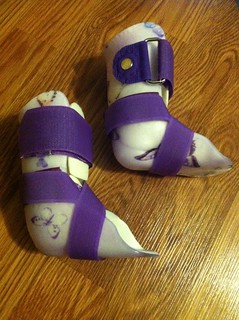
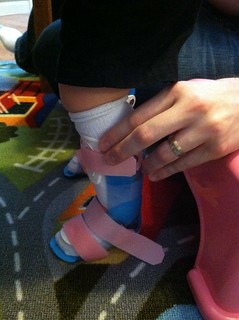
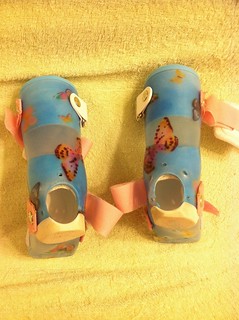
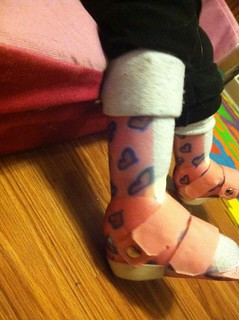
Therapy Suiting: This was recommended as a next step after the neoprene shorts, but we didn't end up pursuing it. It's a body suit with special straps that help to position and/or support the patient. The brand that was recommended is quite expensive and comes with a high frustration quotient. It's intended to be worn under clothing (and diapers), which may or may not be ideal for all patients.
Knee Immobilizers: We used these a lot this spring to help keep Addy's legs stretched out after her surgery and to help get her standing before the KAFOs were fabricated. We also used them for when she wanted to walk out in the community until we noticed that she was developing tibial torsion; she almost exclusively uses the KAFOs for walking now.
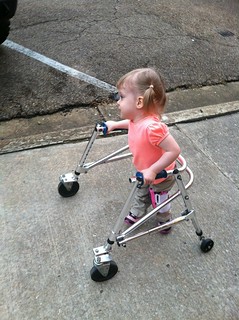
KAFOs (Knee Ankle Foot Orthotics): She got her first pair this spring, following the dual tendon releases. To me Addy's look like HKAFOs (Hip Knee Ankle Foot Orthotics), but I know the Rx we got said KAFOs with drop lock hinges and a belt. We use these all the time now (as in, most days Addy is in her Ks more than her AFOs). They aren't super convenient for walking when we're out and about--she really needs to lay down to get them on correctly and it just takes a few minutes to get all of the straps done up and shoes back on, which is why the knee immobilizers were so great--but they do such a good job of supporting her and keeping her legs aligned correctly. The knee joints on hers have what's called a drop lock; it's a little metal piece that can float down to lock the hinge in place. The hip joints are just hinged with no locks to them. We usually leave the left knee locked, but use a piece of tape to hold the right side in an unlocked position (Addy's left leg is much weaker than the right, so she needs extra support on that side).
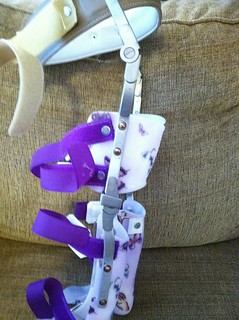
Equipment
Exercise ball: Addy still loves to sit and bounce/rock on her gigantic yoga ball. If you look carefully, you can find ones that are latex-free, but you do have to look. It builds core strength and provides good vestibular input. You can also use it for standing and weight bearing by laying over the ball on your stomach and slowly rock the ball back until your feet touch the floor.
Mobile Stander: Addy got hers when she was about 11 months old--around the time able-bodied kids start pulling up to stand. Hers had big wheelchair-style wheels to it, so she could propel herself around the house (which she learned to do with amazing precision!). Standing is just such a "normal" activity and it does great things for the vestibular system, helps to stimulate bone growth, and having kids at eye-level with their peers is fantastic for their social and verbal development. So much good stuff comes from standing! We attached a standard-issue bike basket to the front of the stander so that Addy could tote toys, books, etc around with her.
Gait Trainer: We used the gait trainer for a relatively short amount of time, but I really think it was the key to getting Addy walking. The brand we had comes with all kinds of accessories and features, so it's really useful across a wide range of diagnoses/needs. It's also kind of overwhelming to try to figure out exactly which settings and accessories you need at any particular time, but it's a fantastic piece of equipment once you find that magic combination. The thing to remember is that as you make progress with strength/balance/endurance/etc, then adjust the equipment to meet the current needs.

(Before surgery)

(3 weeks after surgery)
(6 weeks after surgery)
(3 months after surgery)
Walker: After we got the KAFOs, it seemed like Addy really found the bulk of the gait trainer plus Ks to be too much, so we traded in the gait trainer for a light-weight walker (not unlike the kind adults use, just sized for a smaller person). The one we use is a posterior walker--the frame comes around behind the patient--and it has wheels on all 4 feet. The front wheels can either lock straight or swivel; the back wheels can either roll forward/backward or be set to ratchet forward only. Again, the bike basket is an important feature so that Addy can go pick out a book from the book shelf and then take it to a table to read it (or walk with me to the mailbox to help pick up the mail).
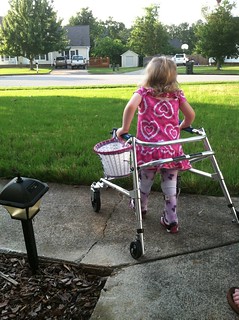
Quad canes ("granny canes"): We tried these once, but Addy is too short right now for the smallest size that our therapy center had. Once she's a little taller, these will probably be the walking aid she'll use.
Parallel bars (or, as Addy calls them, "peril bars"): There are how-to tutorials you can find on the internet for making your own out of PVC or you can order a kit. We're borrowing ours from our therapy center (another family had made them for their child and donated the bars when their child no longer needed them). Ours are about 8.5 feet long, so they take up a LOT of floor space, but it's a good length for walking back-and-forth. Addy uses them at least 3-4 times a week. We decorated ours with butterflies and foam hand prints so she can give her bars high-5s as she's walking.
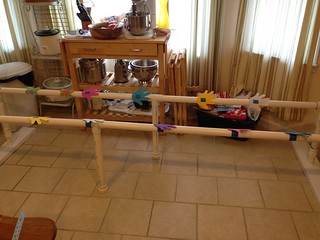
Wheelchair: Yes, this post is mostly about how we've been working on walking but I think it's important to remember that walking is not an all-or-nothing kind of deal. I hadn't realized all of the "kidness" that Addy wasn't getting up to until we started taking her shopping in her wheels. She's able to navigate around the store herself (obviously, we keep an eye on her, but she's able to pick what aisle she wants to go down and what toy or shoes or box of cereal or what-have-you she wants to check out). Your insurance company may disagree, but working on walking does not mean you don't also need to use a wheelchair some (or even most) of the time.
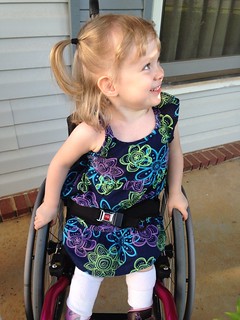
Activities
Ups (a.k.a., sit-to-stands or squats): We used a small stepstool for a bench, parked it and Addy in front of the sofa, and put an irresistible toy just out of reach to encourage her to stand. Addy now does this at the parallel bars by standing with both hands on the same bar and doing squats.
Sofa climbing: Start by taking one or more cushions off the sofa and put them on the floor in front of the sofa. This provides (1) an intermediate step for climbing onto the sofa and (2) and soft place to land if you fall off the sofa (though a safe technique for getting down is a good thing to work on, too). After floor-to-cushion-to-sofa-frame is mastered, take away the cushion so you're going straight from the floor to the sofa frame. Finally, just climb straight from the floor to the sofa (with cushions on the seats like they're supposed to be).

Marching: Either standing on the floor or sitting on a stool, get the legs moving in a marching pattern.
Godzilla attack (and variants): Either standing on the floor or sitting on a stool, stomp on or kick at something that causes a reaction (bubbles, a tower of blocks, toy bowling pin, any toy that lights up or plays a song when you hit a button, your hand--be super dramatic about it because kids love slapstick humor). Growl like Godzilla. Light-up shoes are also effective.
Booty bumps (a.k.a., bridge): Lay on the floor on your back, knees bent, feet flat on the floor. Push up with your legs/abs to raise your backside up off the ground (may need someone to help hold your feet on the floor). If you have a small toy car/truck, try to hold your backside up off the ground long enough for the car to be rolled along under the "bridge" (just be sure you don't accidentally land on the car while it's under you--ouch!).
Treadmill therapy: This was an out-patient therapy we did at our therapy center, but not all centers offer it. It's a harness system that suspends the patient over a treadmill, which allows the therapist to stay seated while helping manipulate the patient's legs in a proper gait pattern. We did 6 weekly sessions when Addy was roughly 18 months old.
Standing at a table/easel: A coffee table at the right height for standing and coloring, painting, reading, playing trains, playing play-doh, etc. A sand and water table is the same idea, though perhaps a bit more messy.
Basketball (or Snaps In The Box): Addy in the gait trainer, starting about 3-4 feet away from me, me holding a small toy for her to come get and then throw into a box (or a ball to throw through a basketball hoop). Simple, but effective.
Cruising: It's so "normal" you almost forget that it's therapeutic. Just like a toddler will cruise the furniture while they transition from standing to walking, it's good for later walkers, too.
Climbing stairs: We have a 2-story house, so every night at bedtime we climb the stairs.
Decorating the patio doors: We have patio doors from the living room out to the back yard, so I got some vinyl stick-ums for Addy to be able to decorate the windows.
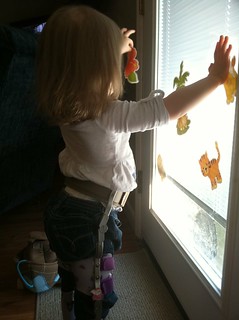
Playhouse: Santa brought a playhouse for Christmas last year. It lived in the living room until it got warm enough to take it outside. Now that it's finally cooling off again, we're playing with it. It has two sides that swing open so you can walk (or roll!) all the way through, and there are lots of doors to walk through and shelves to be able to hold on while you stand/walk/cruise/pull up/etc.
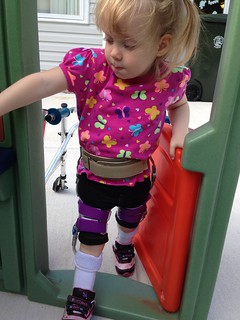
Golf: Helps work on balance, confidence, something fun to do while standing (or sitting in a wheelchair, by the way).
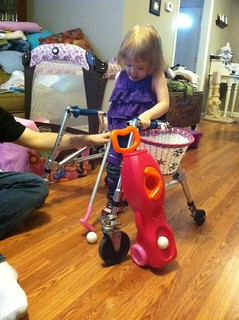
Ready, Steady, Blast-off: I put my arms out on either side of Addy and let her steady herself. When she's ready (and I really think having her decide when she's ready is what's important with this game), she lets go and we take turns counting down from 10 with an exciting "BLAST OFF!" at the end. It's silly, but it's fun. It really got started with Addy standing at the coffee table, trying to psych herself into balancing by herself by telling herself "Ready... Steady... Ready... Steady..." as she would let go of the table briefly.
Yoga/Dancing: Addy really enjoys dancing, so I had taught her how to do "ballet" (really it's just squats with her hands held over her head). I also looked up some kid-friendly yoga poses--her favorites are the tree pose (arms up over your head and sway back and forth) and the rainbow pose (arms up over your head and lean to one side like the arc of a rainbow). Whether doing yoga or dancing, she needs help to stay balanced while standing. If we do seated poses, then obviously we could actually both do them together. Addy also really like Dora, much to my chagrin, but there are several episodes where there are little dances that she likes to do. "Little Einsteins" is another show that has some kind of simple dancing in every episode, and PBS usually has some kind of "get up and move" segment between the kids shows.
Gymnastics: We haven't tried it yet, but I have heard that gymnastics can do wonders for body-awareness, mobility, strength, etc. There is a gym in our area that I know works with special needs kids. I need to give them a call soon to see when they have classes opening up!
First and foremost, my biggest piece of advice is do not take "your child might not be able to..." as an excuse not to try something. It may sound like a glass-half-full-vs-half-empty thing, but "might not" also means "might." You just don't know what your kid can or can't do, so, as long as it's not actually dangerous, let them try! See what they can do and then adapt the activity as needed. Your child will always surprise you.
Bracing and therapeutic garments
Mermaid pants: You can buy these pre-made, but I made a pair myself out of some lycra fabric (sew it into a tube and stitch through the middle at one end to make leg tubes). The point was to help keep the hips and knees in alignment as she was learning to crawl. They really helped with getting into a true hands-and-knees crawl stance, though she obviously couldn't crawl in them with her legs held together. We used them from about 6-9 months old I think.
Neoprene shorts: We really didn't use these a whole lot, but they were the recommended next step after the mermaid pants. They're made out of stiff neoprene, but have actual separate legs instead of the tube shape of the others. They were a major pain to get on her because they need to be tight-fitting, but they don't have any stretch to them at all (we had to bounce her into them, which she thought was hilarious). Because they're pretty stiff, they don't really work well for crawling, but they do offer some hip support for standing. Maybe if we had used them more often, they would have broken in and been softer for crawling.

AFOs (Ankle Foot Orthotics): Addy got her first pair right after she got her stander and she's outgrown them about every 8-9 months or so (she's on her 3rd pair right now). The 2nd and 3rd ones were fabricated by an off-site vendor that is very popular with some people and not at all popular with us. I plan to really push for ones that are made in-house by our orthotist (or at least by a different off-site vendor) this fall.




Therapy Suiting: This was recommended as a next step after the neoprene shorts, but we didn't end up pursuing it. It's a body suit with special straps that help to position and/or support the patient. The brand that was recommended is quite expensive and comes with a high frustration quotient. It's intended to be worn under clothing (and diapers), which may or may not be ideal for all patients.
Knee Immobilizers: We used these a lot this spring to help keep Addy's legs stretched out after her surgery and to help get her standing before the KAFOs were fabricated. We also used them for when she wanted to walk out in the community until we noticed that she was developing tibial torsion; she almost exclusively uses the KAFOs for walking now.

KAFOs (Knee Ankle Foot Orthotics): She got her first pair this spring, following the dual tendon releases. To me Addy's look like HKAFOs (Hip Knee Ankle Foot Orthotics), but I know the Rx we got said KAFOs with drop lock hinges and a belt. We use these all the time now (as in, most days Addy is in her Ks more than her AFOs). They aren't super convenient for walking when we're out and about--she really needs to lay down to get them on correctly and it just takes a few minutes to get all of the straps done up and shoes back on, which is why the knee immobilizers were so great--but they do such a good job of supporting her and keeping her legs aligned correctly. The knee joints on hers have what's called a drop lock; it's a little metal piece that can float down to lock the hinge in place. The hip joints are just hinged with no locks to them. We usually leave the left knee locked, but use a piece of tape to hold the right side in an unlocked position (Addy's left leg is much weaker than the right, so she needs extra support on that side).

Equipment
Exercise ball: Addy still loves to sit and bounce/rock on her gigantic yoga ball. If you look carefully, you can find ones that are latex-free, but you do have to look. It builds core strength and provides good vestibular input. You can also use it for standing and weight bearing by laying over the ball on your stomach and slowly rock the ball back until your feet touch the floor.
Mobile Stander: Addy got hers when she was about 11 months old--around the time able-bodied kids start pulling up to stand. Hers had big wheelchair-style wheels to it, so she could propel herself around the house (which she learned to do with amazing precision!). Standing is just such a "normal" activity and it does great things for the vestibular system, helps to stimulate bone growth, and having kids at eye-level with their peers is fantastic for their social and verbal development. So much good stuff comes from standing! We attached a standard-issue bike basket to the front of the stander so that Addy could tote toys, books, etc around with her.
Gait Trainer: We used the gait trainer for a relatively short amount of time, but I really think it was the key to getting Addy walking. The brand we had comes with all kinds of accessories and features, so it's really useful across a wide range of diagnoses/needs. It's also kind of overwhelming to try to figure out exactly which settings and accessories you need at any particular time, but it's a fantastic piece of equipment once you find that magic combination. The thing to remember is that as you make progress with strength/balance/endurance/etc, then adjust the equipment to meet the current needs.

(Before surgery)

(3 weeks after surgery)
(6 weeks after surgery)
(3 months after surgery)
Walker: After we got the KAFOs, it seemed like Addy really found the bulk of the gait trainer plus Ks to be too much, so we traded in the gait trainer for a light-weight walker (not unlike the kind adults use, just sized for a smaller person). The one we use is a posterior walker--the frame comes around behind the patient--and it has wheels on all 4 feet. The front wheels can either lock straight or swivel; the back wheels can either roll forward/backward or be set to ratchet forward only. Again, the bike basket is an important feature so that Addy can go pick out a book from the book shelf and then take it to a table to read it (or walk with me to the mailbox to help pick up the mail).

Quad canes ("granny canes"): We tried these once, but Addy is too short right now for the smallest size that our therapy center had. Once she's a little taller, these will probably be the walking aid she'll use.
Parallel bars (or, as Addy calls them, "peril bars"): There are how-to tutorials you can find on the internet for making your own out of PVC or you can order a kit. We're borrowing ours from our therapy center (another family had made them for their child and donated the bars when their child no longer needed them). Ours are about 8.5 feet long, so they take up a LOT of floor space, but it's a good length for walking back-and-forth. Addy uses them at least 3-4 times a week. We decorated ours with butterflies and foam hand prints so she can give her bars high-5s as she's walking.

Wheelchair: Yes, this post is mostly about how we've been working on walking but I think it's important to remember that walking is not an all-or-nothing kind of deal. I hadn't realized all of the "kidness" that Addy wasn't getting up to until we started taking her shopping in her wheels. She's able to navigate around the store herself (obviously, we keep an eye on her, but she's able to pick what aisle she wants to go down and what toy or shoes or box of cereal or what-have-you she wants to check out). Your insurance company may disagree, but working on walking does not mean you don't also need to use a wheelchair some (or even most) of the time.

Activities
Ups (a.k.a., sit-to-stands or squats): We used a small stepstool for a bench, parked it and Addy in front of the sofa, and put an irresistible toy just out of reach to encourage her to stand. Addy now does this at the parallel bars by standing with both hands on the same bar and doing squats.
Sofa climbing: Start by taking one or more cushions off the sofa and put them on the floor in front of the sofa. This provides (1) an intermediate step for climbing onto the sofa and (2) and soft place to land if you fall off the sofa (though a safe technique for getting down is a good thing to work on, too). After floor-to-cushion-to-sofa-frame is mastered, take away the cushion so you're going straight from the floor to the sofa frame. Finally, just climb straight from the floor to the sofa (with cushions on the seats like they're supposed to be).

Marching: Either standing on the floor or sitting on a stool, get the legs moving in a marching pattern.
Godzilla attack (and variants): Either standing on the floor or sitting on a stool, stomp on or kick at something that causes a reaction (bubbles, a tower of blocks, toy bowling pin, any toy that lights up or plays a song when you hit a button, your hand--be super dramatic about it because kids love slapstick humor). Growl like Godzilla. Light-up shoes are also effective.
Booty bumps (a.k.a., bridge): Lay on the floor on your back, knees bent, feet flat on the floor. Push up with your legs/abs to raise your backside up off the ground (may need someone to help hold your feet on the floor). If you have a small toy car/truck, try to hold your backside up off the ground long enough for the car to be rolled along under the "bridge" (just be sure you don't accidentally land on the car while it's under you--ouch!).
Treadmill therapy: This was an out-patient therapy we did at our therapy center, but not all centers offer it. It's a harness system that suspends the patient over a treadmill, which allows the therapist to stay seated while helping manipulate the patient's legs in a proper gait pattern. We did 6 weekly sessions when Addy was roughly 18 months old.
Standing at a table/easel: A coffee table at the right height for standing and coloring, painting, reading, playing trains, playing play-doh, etc. A sand and water table is the same idea, though perhaps a bit more messy.
Basketball (or Snaps In The Box): Addy in the gait trainer, starting about 3-4 feet away from me, me holding a small toy for her to come get and then throw into a box (or a ball to throw through a basketball hoop). Simple, but effective.
Cruising: It's so "normal" you almost forget that it's therapeutic. Just like a toddler will cruise the furniture while they transition from standing to walking, it's good for later walkers, too.
Climbing stairs: We have a 2-story house, so every night at bedtime we climb the stairs.
Decorating the patio doors: We have patio doors from the living room out to the back yard, so I got some vinyl stick-ums for Addy to be able to decorate the windows.

Playhouse: Santa brought a playhouse for Christmas last year. It lived in the living room until it got warm enough to take it outside. Now that it's finally cooling off again, we're playing with it. It has two sides that swing open so you can walk (or roll!) all the way through, and there are lots of doors to walk through and shelves to be able to hold on while you stand/walk/cruise/pull up/etc.

Golf: Helps work on balance, confidence, something fun to do while standing (or sitting in a wheelchair, by the way).

Ready, Steady, Blast-off: I put my arms out on either side of Addy and let her steady herself. When she's ready (and I really think having her decide when she's ready is what's important with this game), she lets go and we take turns counting down from 10 with an exciting "BLAST OFF!" at the end. It's silly, but it's fun. It really got started with Addy standing at the coffee table, trying to psych herself into balancing by herself by telling herself "Ready... Steady... Ready... Steady..." as she would let go of the table briefly.
Yoga/Dancing: Addy really enjoys dancing, so I had taught her how to do "ballet" (really it's just squats with her hands held over her head). I also looked up some kid-friendly yoga poses--her favorites are the tree pose (arms up over your head and sway back and forth) and the rainbow pose (arms up over your head and lean to one side like the arc of a rainbow). Whether doing yoga or dancing, she needs help to stay balanced while standing. If we do seated poses, then obviously we could actually both do them together. Addy also really like Dora, much to my chagrin, but there are several episodes where there are little dances that she likes to do. "Little Einsteins" is another show that has some kind of simple dancing in every episode, and PBS usually has some kind of "get up and move" segment between the kids shows.
Gymnastics: We haven't tried it yet, but I have heard that gymnastics can do wonders for body-awareness, mobility, strength, etc. There is a gym in our area that I know works with special needs kids. I need to give them a call soon to see when they have classes opening up!
Look who's ready steady now
Nora did some free standing last night. She had pulled up at the book shelf and grabbed a toy in each hand. Just standing there, not holding onto anything. Prayers are appreciated.
Monday, August 26, 2013
More sewing craft projects
Addy has made it a daily request that she get to work on a sewing craft project with mommy. While we haven't managed to do one every night, we have done something several nights now. Last night we started on a multi-night project of making her a pillowcase-style sundress.
This morning she wanted to add pockets. And make a matching purse. And a dress for Nora.
And speaking of Nora, I started playing around with what to do for her baptism dress.
So far, some form of beaded smocking is what I'm leaning toward, but with white beads on white fabric. I would go ahead and make something out of the red/off-white sample, but the red paint kept rubbing off the silly beads. Not a good quality for beads to have, especially if they're going to be used for clothing on a drooling, chewing 10 month old.For those who don't know or don't remember, Addy's dress was made from the train from my wedding dress. I'm planning to use some of the rest of the beads from my wedding dress for the smocking on Nora's dress.
Wednesday, August 21, 2013
Mommy gets deep again
There are 4 kinds of knowledge in the universe:
1) The things you know you know.
2) The things you know you don't know.
3) The things you don't know that you know.
4) The things you don't know that you don't know. Sometimes these masquerade as category 2 pieces of knowledge, but it's usually the true vastness of your lack of knowledge that distinguishes this category.
Which brings me to my current, honest-to-goodness category 4, never-knew-that-I-didn't-know-it, deep thought: disability models. I had never heard the concept of a disability model, let alone the specifics of either the medical or the social model, and I have really only started putting any effort into figuring what they are and what they mean for us as a family adapting with Spina Bifida. And Hydrocephalus. And Chiari Malformation. And their secondary symptoms.
I'm over-simplifying, but here are some basic definitions I've come across. The medical model is a construct in which the disability or impairment is seen as needing medical intervention in order to bring the person to a state of "normal." The disability must be treated/addressed because quality of life is reduced as a direct result of not being "normal." By contrast, the social model makes a distinction between a disability and an impairment. It says that an impairment is the physical inability to do something like walking and is caused by damage, injury, malformation of the body. A disability, on the other hand, is a barrier created by society. A person who uses a wheelchair isn't disabled because they have mobility impairment. Rather, they are disabled by the lack of ramps/elevators in public places.
1) The things you know you know.
2) The things you know you don't know.
3) The things you don't know that you know.
4) The things you don't know that you don't know. Sometimes these masquerade as category 2 pieces of knowledge, but it's usually the true vastness of your lack of knowledge that distinguishes this category.
Which brings me to my current, honest-to-goodness category 4, never-knew-that-I-didn't-know-it, deep thought: disability models. I had never heard the concept of a disability model, let alone the specifics of either the medical or the social model, and I have really only started putting any effort into figuring what they are and what they mean for us as a family adapting with Spina Bifida. And Hydrocephalus. And Chiari Malformation. And their secondary symptoms.
I'm over-simplifying, but here are some basic definitions I've come across. The medical model is a construct in which the disability or impairment is seen as needing medical intervention in order to bring the person to a state of "normal." The disability must be treated/addressed because quality of life is reduced as a direct result of not being "normal." By contrast, the social model makes a distinction between a disability and an impairment. It says that an impairment is the physical inability to do something like walking and is caused by damage, injury, malformation of the body. A disability, on the other hand, is a barrier created by society. A person who uses a wheelchair isn't disabled because they have mobility impairment. Rather, they are disabled by the lack of ramps/elevators in public places.
(There's more to both theories and I would encourage you to read up on them and form your own opinions.)
There are elements of each that seem true to me. From the medical model, it seems obvious that when quality of life can truly be improved by medical intervention, then medical intervention should be sought out (or at least considered). If we break a leg or get strep throat, most of us would go to the doctor and seek treatment with the goal being to return the body to a "normal" (pre-injury/illness) state. I think the real flaw in this as a framework for treating/managing a chronic condition is in who gets to define what is an improvement in quality of life. Ultimately I think that should be left up to the person who has the disability, though, there are situations in which that person isn't able to decide, due to age or mental impairment or what have you. I have to admit that deciding what is/isn't in the long-term best interest of another person is one of the challenges of parenting that I dislike the most (yes, I think it applies to parenting in general, though there are more opportunities to question your motives when you are caring for someone who has a disability). I want Addy to have the best chance at an active, independent, happy, full life and I want any procedure or therapy to lead to that goal.
On the other hand, the social model with its almost defiant "there's nothing wrong with me; I was born different but different isn't bad" attitude is somewhat refreshing. What turns me off from it is the blame shifting that goes on. "I, as an impaired person, don't need to adapt. Society put up these barriers; society needs to change." That really rubs me wrong. It builds a lifetime of confrontation and aggression that, in my opinion, leads to wasted energy.
The social model also seems to neglect how we got to be a society of stairs and other barriers. Society didn't decide that multi-story buildings are a good idea in order to intentionally exclude people who use wheelchairs or canes. Stairs came into being as a way to efficiently use real estate. I'm not saying that we shouldn't all work diligently to remove barriers like stairs and be more universally inclusive. I'm just saying that perhaps a less angry and confrontational attitude might be called for when trying to navigate the world (which is very easy to say when you're someone who is able-bodied and hasn't faced a lifetime of stairs I couldn't climb.)
So what does this mean for us as a family that is adapting, navigating, and occasionally fumbling through life due to a disability/impairment? An excellent question for which I don't have a complete answer. Neither model truly fits me and my hopes for my family, but I want to draw on each to help Addy make sense of Spina Bifida. Certainly, as she gets older and is able to participate in her medical decisions, I'm going to encourage Addy to form her own opinions and to decide what will make her life better. And I definitely want her to know that different isn't bad and that there are likely more commonalities than there are differences between her and her peers. But I also want her to know how to adapt, how to look at a situation and figure out how to make it work for her, and to not take "you can't do that, you're disabled" from anyone. I want her to kick Spina Bifida squarely in the ass and have fun doing it. I want her to know that her diagnoses are part of who she is, but they don't define her and she can redefine them. Most of all, I want her to have a happy and full life.
And now you know some of the things that, until recently, I didn't know that I didn't know, but now I know that I don't know enough about them. Y'know?
Sunday, August 18, 2013
Betcha didn't realize you could swap like that
I blame the lack of sleep that comes with being a parent to 2 under 3, but one time Addy requested to sing "Jesus Loves Me" and I accidentally started singing it to the tune of "Twinkle Twinkle Little Star" (aka, "ABCs" for those who didn't realize that that's the same tune). It totally fits, by the way, but it's REALLY hard to do it on purpose because you keep wanting to sing the words that go with the tune after you get through the first line or so. Let's face it, though, "Jesus loves me this I know, How I wonder what you are" just doesn't really make a lot of sense.
Along those lines, we're getting Addy used to coming into the church service with us on Sunday mornings. She loves to sing, but she doesn't read yet, so she and I just sing the words to "Jesus Loves Me" to the tune of whatever hymn everyone else is singing. It's gotta be interesting sitting near us at church.
Newest baby
Addy requested to "work on a sewing craft project" with me this afternoon. I suggested that we could work on Nora's baptism dress. She countered with "How about an iguana instead." So after nap she and I made Lucy the Lima-Filled Lizard.
Wednesday, August 14, 2013
Juggling act
The girls are at the point where they're about equal in their ability to pull to stand and their desire to try to walk (all the time). Unfortunately Addy's walker is oh-so-shiny and tempting to poor Nora and I'm concerned she may get a finger pinched (or worse!) if she gets too close. There is no "Nora plays over here with some toys while Addy walks around over there and plays with her toys." Nora crawls and chases Addy and, when she catches her, tries to pull up on the walker. And she's a fast little bugger, too! On the up side, I don't think it's going to take Nora all that long to figure out how to walk, so this should be a non-issue before too long. We'll just have to worry about them running after each instead.
Saturday, August 10, 2013
New experience
Addy got to try out an AmTryke hand trike this morning. She was a little hesitant at first about the whole my-hands-AND-my-feet-move-at-the-same-time? thing, and she definitely was not happy with the weirdness that is a bike helmet. But she overcame both of those aspects and is really excited about getting a trike of her own. (A bit too excited methinks; it will be a little a while because our local AMBUCS club does a big order to make the most of the freight shipping charges.) Based on the helmet fiasco, we went ahead and procured a bike helmet to let Addy get used to it while she waits for the trike.
Tuesday, August 6, 2013
What could be more "normal"?
We get to take Addy for an AmTryke fitting this weekend--so excited! She has been begging for a real bike lately (Dino Truck is really too small for her and her crazy long legs now).
Saturday, August 3, 2013
Of course she's right. She's ALWAYS right.
Addy keeps repeating "Do fish know Christmas or are they confused?" Thinking that this was just yet another instance of 2 year olds are BSC (bat-scat crazy), we tried to just answer the question. Obviously, fish are confused, just like the rest of us are by this weird and philosophical question.
No matter how many times we answered the question, we didn't seem to be getting it right because Addy just kept repeating the nonsense. "Do fish know Christmas or are they confused?" As Derek said, it's like she an alien or something and if we can just solve the riddle, then the secrets of the universe will be revealed to us. But neither "They know Christmas" NOR "They're confused" made the question go away. We were all getting confused. And annoyed.
Cue Google.
I googled "Do fish know Christmas or are they confused" and got a hit: a blog post from a parent whose kid had watched the Curious George Christmas movie on PBS. That little bugger, Steve, made up a stupid Christmas song to the tune of "We Wish You A Merry Christmas".
Do fish know that it is Christmas?
Do fish know that it is Christmas?
Do fish know that it is Christmas?
Or are they confused?
Apparently the irritating song has been an ear worm, stuck in poor Addy's head all day. Now it's stuck in my head, too. Thanks, Steve.
This word, I do not think it means what you think it means
Addy: My watch is fast.
Daddy: Really? Your watch?
Addy: Yeah (looking at her naked wrist). It's fast.
Daddy: What does it mean when your watch is fast?
Addy: (Shaking her head and gesturing quickly) Fast, fast, fast!!
Friday, August 2, 2013
I hate to disappoint you, dear
Thanks to a combination of Dora, preschool, and a very vivid imagination, I was informed several times today that we will be going on a family trip to the beach so that Addy can dig in the sand, swim like a fish, play with a basketball, and eat peaches with her daddy. Oh, and we're leaving tonight.
It sounds very lovely, but driving several hours to get to the beach wasn't really what I had in mind for this weekend.
Thursday, August 1, 2013
Now we're rolling
We took Addy's wheelchair back to the dealer's office this afternoon to see what they could do about the brakes--success!
Subscribe to:
Posts (Atom)








